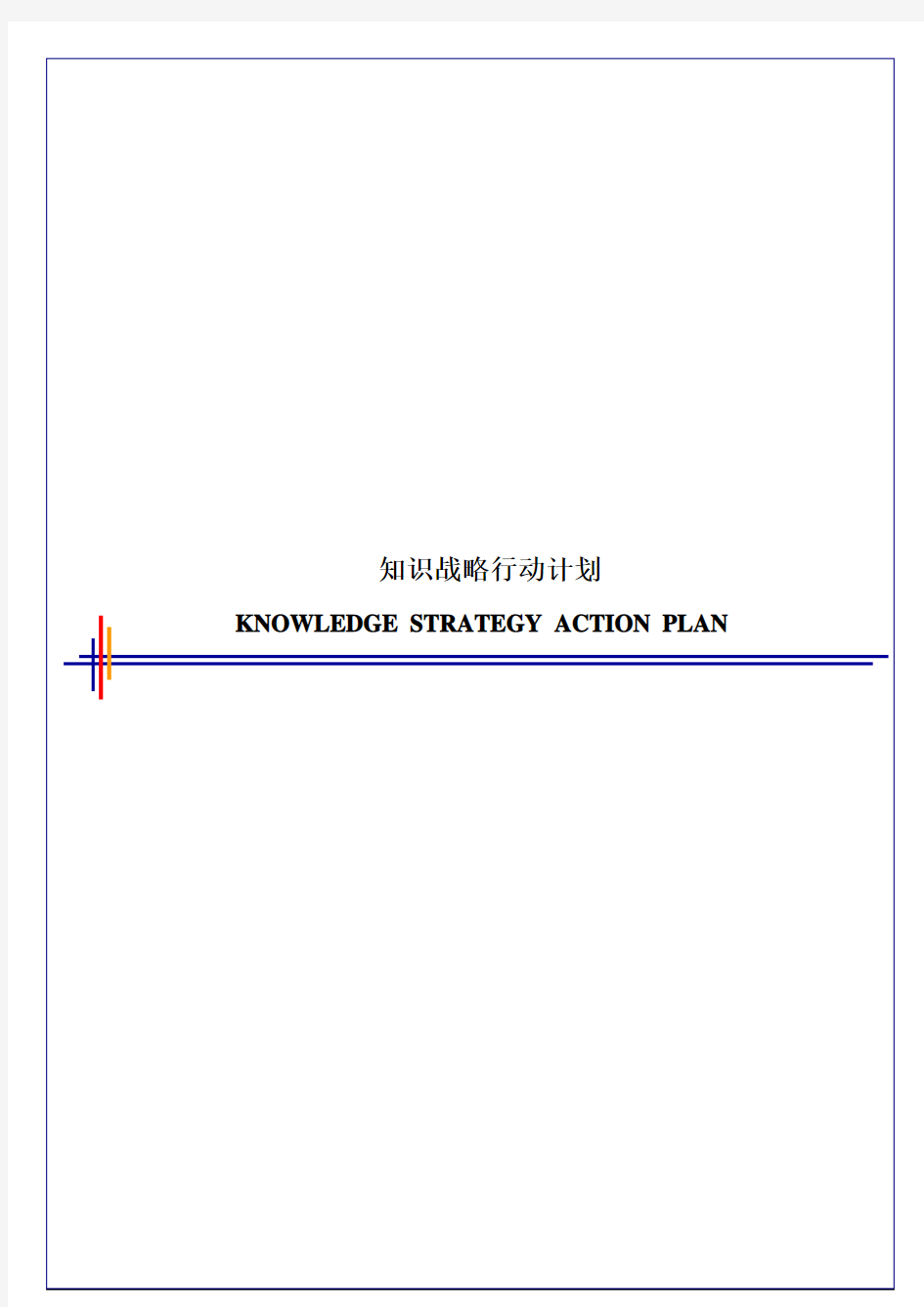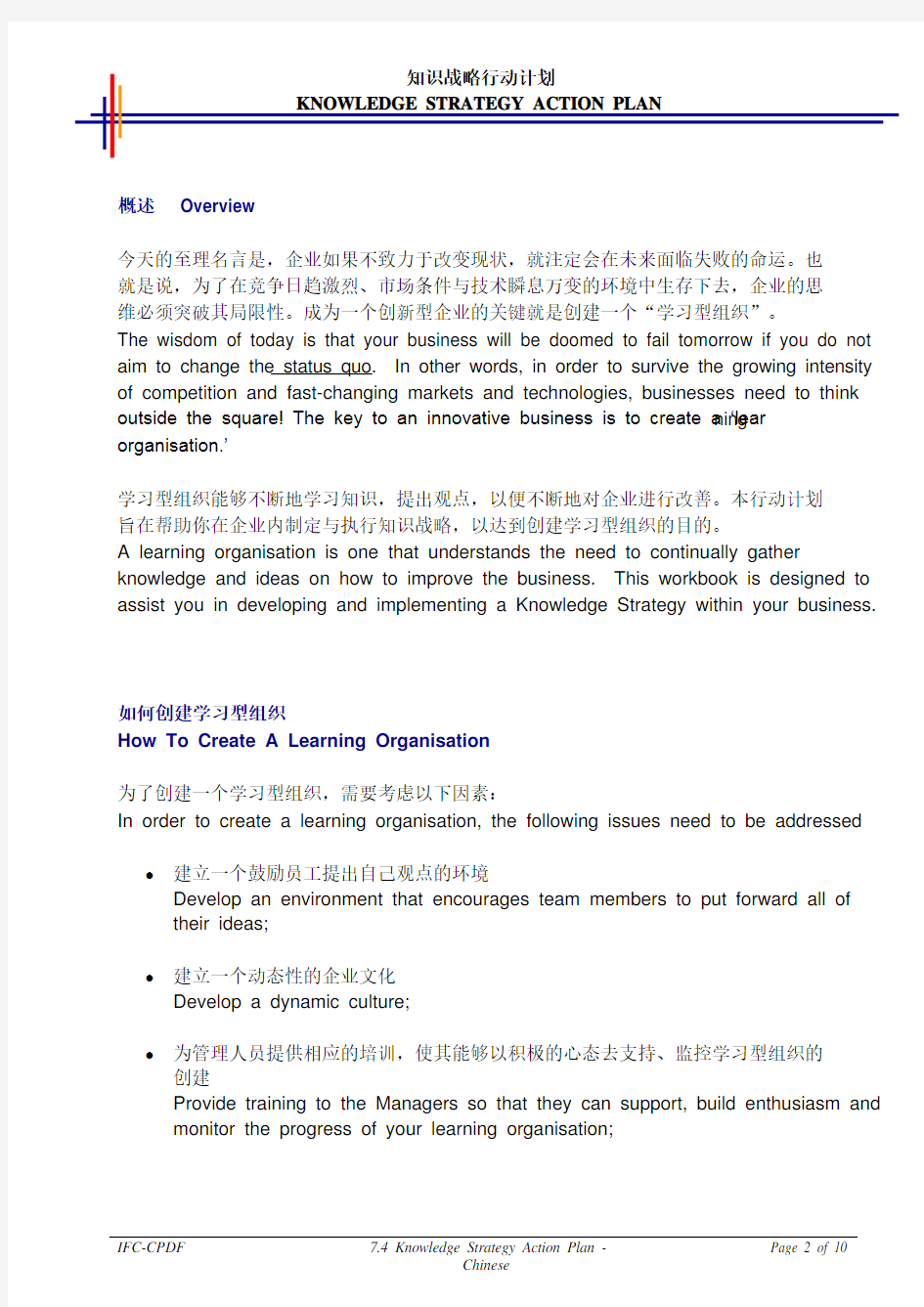

概述 Overview
今天的至理名言是,企业如果不致力于改变现状,就注定会在未来面临失败的命运。也就是说,为了在竞争日趋激烈、市场条件与技术瞬息万变的环境中生存下去,企业的思维必须突破其局限性。成为一个创新型企业的关键就是创建一个“学习型组织”。
The wisdom of today is that your business will be doomed to fail tomorrow if you do not aim to change the status quo. In other words, in order to survive the growing intensity of competition and fast-changing markets and technologies, businesses need to think outside the square! The key to an innovative business is to create a ‘lear ning organisation.’
学习型组织能够不断地学习知识,提出观点,以便不断地对企业进行改善。本行动计划旨在帮助你在企业内制定与执行知识战略,以达到创建学习型组织的目的。
A learning organisation is one that understands the need to continually gather knowledge and ideas on how to improve the business. This workbook is designed to assist you in developing and implementing a Knowledge Strategy within your business.
如何创建学习型组织
How To Create A Learning Organisation
为了创建一个学习型组织,需要考虑以下因素:
In order to create a learning organisation, the following issues need to be addressed ?建立一个鼓励员工提出自己观点的环境
Develop an environment that encourages team members to put forward all of
their ideas;
?建立一个动态性的企业文化
Develop a dynamic culture;
?为管理人员提供相应的培训,使其能够以积极的心态去支持、监控学习型组织的创建
Provide training to the Managers so that they can support, build enthusiasm and monitor the progress of your learning organisation;
?持续地进行市场与竞争对手调查,并从中获得如何改进体系与技术的观点Continually research the marketplace and your competitors in order to generate
ideas on how to improve systems and technology;
?保持一个企业战略不是静态的,是可以改变与创新的态度
Adopt the attitude that change and innovative business strategies are acceptable, static is not!
1. 在你的企业中,你认为以上的哪些方面是需要重视的?请说明原因。
In your business, do you believe that any of the above issues need to
addresses? Please explain below.
发展与毁灭
Evolve or Perish
我们正处于一个全球性竞争与瞬息万变的时代,为了在竞争中取得成功,企业必须不断
地变革。为了达到这一点,企业必须拥有最先进的技术,不断地生产出新的产品与服
务。如果不这样做,企业最终会走向失败。为了保持竞争力,企业必须通过以下方式来
建立自己的技术:
We now exist in a dynamic world of global competition where organisations must evolve in order to compete successfully. To do this, businesses have to continually create new products and services that embrace the latest technology. Those who do not will ultimately perish. To remain competitive, your business needs to build its knowledge by:
?认识到,一个动态的世界需要一个动态的方法
Being aware that a dynamic world requires a dynamic approach;
?持续研究创新的方式,开发新产品与服务
Continually researching innovative ways to develop new products and services; and
?了解最新技术,并将其运用于创造自己的优势
Being aware of the latest technology and using it to your advantage
2. 你认为你的企业会保持竞争优势吗?如果不能,你认为企业应当怎样做?
Do you believe that your business can remain competitive? If no, what issues do you believe that the business needs to address?
激发创新
Stimulating Innovation
通过激发创新来将企业建立成一个学习型组织。
Develop your business into a learning organisation by stimulating innovation.
鼓励创新的企业具有以下特点:
Businesses that stimulate innovation have:
?结构很灵活
Structures that are flexible;
?易于获得资源
Easy access to resources;
?沟通渠道畅通
Fluid communications;
?拥有一个放松、支持新观点、鼓励改变环境的企业文化
A culture that is relaxed, supportive of new ideas and encourages monitoring of
the environment; and
?创新性员工受到良好的培训,被安置在适合的岗位,并安于该职位。
Creative people who are well trained, current in their fields and are secure in their jobs
3. 你认为贵公司激励创新吗?为了激励创新,企业应该做出什么样的改进?
Do you believe that your business stimulates innovation? What
improvements do you think the business could make in order to stimulate innovation?
创建企业文化
Developing Your Culture
创建学习型组织的一部份工作,就是创建一个“学习文化”。为了达到这一目的,需要企业具备以下特质:
Part of the process of developing a learning organization is to create a ‘learning culture’ To do this, the following characteristics need to be present:
?理解模糊概念的作用
Understanding of the function of ambiguity;
?理解不切实际的使用
Understanding of the function of impractical;
?摆脱外部环境的影响
Freedom from external influence
?接受风险,并理解风险的作用
Ability to accept and understand the role risk; and
?接受冲突,并理解冲突的作用
Ability to accept and understand the role of conflict.
4. 贵企业是否具备这些特质?如果不具备,企业应当做什么样的改进?
Are these characteristics present in your business? If no, what changes do you believe you need to make?
征求客户意见
A sk Your Customers
在收集如何改善企业方面,客户是你的最佳资源。
Your customers are an excellent source for gathering knowledge on how to improve your business
?征求客户的意见,寻求他们的帮助
Ask your customers for their input;
?密切关注客户,收集他们的观点与建议
Pay close attention to your customers and combine their ideas with your own;
?总是将客户观察所得与客户提问结合在一起
Combine customer observation and enquiry at all times;
?学习识别在什么情况下,客户不会说出他们的需求
Learn to recognise situations where customers can not say what they need; and
?确保技术得到改进,而不会阻碍企业的流程
Ensure that technology improves rather than hinders your business processes.
5. 你认为你从客户那里收集知识吗?在这方面,你可以做出什么样的改进?
Do you believe that you gather knowledge from your customers? What
improvements do you believe that you could make in this area?
模块: Module: 行政管理Administration 流程: Process: 安全Security 系统: System: 现金管理 Cash Handling 系统执行人 System Champion: 经理Manager 目标 Objectives: ?按照正确的程序以确保正确、精确地管理所有现金 To follow the correct procedure to ensure that all handling of cash is carried out accurately and diligently 程序 Procedure: ?当收到50元和100元面额的钞票时,员工应该口述“收到50元”或“收到100元”。 When receiving ¥50 & ¥100 notes, the team member must say “check ¥50” or check “¥100”. ?所有已付款的金额都应该记入帐目。 The amount tendered must always be keyed into the till. ?总是给客户一张收据 Always give the customer a receipt. ?应避免在各种帐目间挪用现金。好的管理应是准确地为每种帐目计划金额和按要求命名储备金。如果你不得不挪用现金,必须从另一种帐目中“买出”,例如,从一种帐 目中”买入”50元面额钞票, 就需要从另一个帐目卖出5张10元面额的钞票。 Swapping money between tills should be avoided. Good management practices include accurately planning the amount and required denomination of the float for each till. If you do have to swap monies then the money must be “bought” from one till to another e.g. a ¥50 note from one till will be exchanged with 5 x ¥10 notes from the other till. ?确保在已锁的抽屉或保险柜内存放有零钞 Spare change must be kept in either a locked drawer or in the safe
模块:Module: 行政管理Administration 流程:Process: 邮件和快递 Mail and Couriers 系统:System: 如何安排一份快递 How to Arrange a Courier 系统执行人:System Champion: 接待员Receptionist 目标: Objectives: 依正确程序安排一份快递 To follow the correct procedures to arrange a courier 确保所有包裹都传送到正确的地方 To ensure that all packages are delivered to the correct address 确保所有包裹都传送给正确的人 To ensure that all packages are delivered to the correct person 程序: Procedure: 与送信人确认适当的联系方式和详细地址 Confirm with the sender the appropriate contact and address details 在客户/顾客/供应商数据库中确认详细资料 Confirm details with client/customer/supplier database 将文档放入合适规格的信封或包裹中,确保内容的安全。 Place documents in appropriately sized envelope or package ensuring that the contents are secure 同与企业有往来账户的快递商联系 Contact the courier service for which the business has a trading account
管理咨询35种经典工具 全书三分钟快速阅读版 本书系统地介绍了在日常管理活动当中,经常用到的35种经典工具,这些工具包括公司战略分析与战备管理、战略决策、人力资源管理等多个方面,每种工具首先介绍工具的来源和使用方法,然后结合经典案例进一步进行了说明。 PEST分析法是进行外环境分析的常用工具,从政治、法律、经济、社会、文化和技术的角度,分析环境变化对于企业影响的一种方法。 波特五力量分析主要用于产业环境中对于是产业竞争的性质的该产业中所具有的潜在利润的分析。是由波特教授提出的“五种力量模型”,即潜在竞争对手、现有企业之间的竞争、替代品的威胁、供方的讨价还价能力和买方的讨价还价能力。 行业竞争结构分析使企业管理者可以从定性和定量两个方面分析行业竞争结构和竞争状况,以达到以下两个目的:分析确定五力中影响企业成败的关键因素;企业高层管理者从与这一集团相关的各因素中找出需要立即对付或处理的威胁,以便及时采取行动。 利益相关者分析用于分析与企业利益相关的所有个人和组织,帮助企业在战略制定时分清重大利益相关者对于战略影响。 生命周期理论也是判断产业竞争状况的一个最为普遍采用的模型。模型的基础就是认为市场的不同状态即市场处于从开发到成熟的什么阶段从根本上影响竞争条件和企业的行为。 SWOT分析将企业外部环境的机会(O)与威胁(T),内部环境的优势(W)与劣势(S)罗列在一张十字形图表中加以对照,可以一目了然地看出企业的环境情况,又可以从内部环境条件的相互联系中作出更深入的分析评价。 战略地位和行动评估矩阵是战略方向选择的工具,在SWTO分析的基础上,通过确定两组具体反映客房外部的量化指标,更加准确地进行战略的选择和定位。 雷达图是对企业财务能力分析的重要工具,从动态和静态两个方面分析企业的财务状况。 价值链分析的核心是将客户的所有资源、价值活动与客户的战略目标紧密连接起来,以价值增值为目的,形成了一个简明而清晰的结构框架,帮助客户清晰认识客户中相关各链条的重要意义。
管理咨询及人力资源咨询常用的132项工具.doc 1 战略框架 2 战略实施模型 3 波特价值链分析 4 战略管理过程 5 洛克希德法 6 组织变革的战略类型 7 决策树 8 基础统计技术 9 蒙特卡罗模拟技术 10 阿姆科公司事前测感技术 11 希布纳的预测七原则 12 组织决策的卡耐基模式 13 阿尔布雷克特组织政治分析 14 赋权分析矩阵 15 马斯洛的人类需求五层次理论 16 赫茨伯格的双因素理论 17 奥德费ERG理论 18 麦克利兰成就激励理论 19 波特和劳勒的综合激励模型 20 期权的六要素法 21 弗鲁姆期望理论
22 亚当斯公平理论 23 斯金纳强化理论 24 埃德温洛克目标设置理论 25 股权陷阱规避法 26 工作分析信息的种类 27 工作分析的步骤 28 因素比较法 29 因素计点法 30 分类法 31 排序法 32 问卷法 33 访谈法 34 工作日志法 35 实践法 36 结构化面试法 37 丰田公司选拔计划 38 岗位评价的权重系数确定法 39 管理评价中心法 40 内部选拔的方法 第一页第二页第三页第四页 41 外部选拔的方法 42 员工的投入与收益分析法
43 格兰丘纳斯的上下级关系理论 44 效率\设备\岗位\比例定员法 45 平衡记分法 46 胜任特征模型 47 明尼苏达多相个性测验 48 艾森格人格测验 49 卡特尔16种因素测验 50 比奈-西蒙智力测验 51 罗夏墨迹测验 52 勒温的场论 53 卡兹的组织寿命学说 54 库克创造力曲线 55 默里与摩根的主题统觉测验 56 皮亚尔故事测验 57 科尔伯格两难故事测验 58 中松义郎的目标一致理论 59 赫茨伯格工作丰富化模型 60 比德返转原理 61 冲击晋升模式分析 62 蔓藤晋升模式分析 63 旅行保险公司工作丰富模型 64 TRW五合一